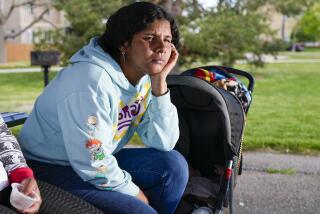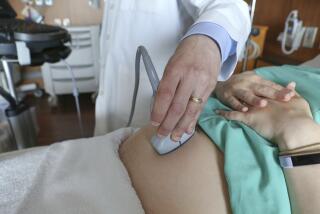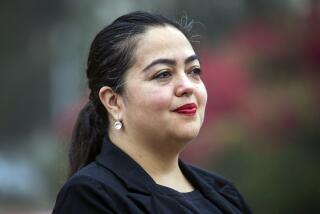In the Hours Following Childbirth . . . : . . . There’s Pain, Fatigue, Bonding and Joy-- but When Should Mom Go Home?
- Share via
The debate over how soon is too soon to send a mother and newborn home from the hospital is heating up.
In April, Kaiser Permanente, Los Angeles introduced a voluntary program whereby mothers could be discharged as early as eight hours after childbirth. (On average, eligible mothers have been staying 15 hours.)
In May, the American College of Obstetricians and Gynecologists issued a statement of concern about the decreasing length of hospital stays. And on Wednesday, the American Medical Assn.’s governing body adopted a recommendation that the physician’s judgment--not health care costs--should guide the decision to discharge.
The issue is complicated, since what happens in the first few hours after childbirth is as unique as each new set of tiny footprints.
Here is how one San Fernando family’s childbirth experience earlier this week unfolded over the first eight hours.
*
Monday, June 19, 1995, 6:55 p.m.: For several hours, Aurora Caudillo had been curled up in a labor room bed at Valley Presbyterian Hospital in Van Nuys, shifting her weight to ease the pain of contractions. But now it’s over.
Her obstetrician, Dr. Kamrooz Houman, has just delivered a 7-pound, 12-ounce boy--just a bit above average for a full-term baby. He is 20 1/2 inches long with a shock of dark hair. This delivery, as one nurse describes it later, is a textbook example of an uncomplicated vaginal birth. Caudillo received only a bit of local anesthetic.
The baby’s Apgar scores, taken at one minute and five minutes after birth to assess health status on a 10-point scale, look good. He first earns an 8 and then a 9.
7:22 p.m.: Nurse Sarah Baldwin bounds out of the delivery room, wheeling the newborn’s Isolette and asking, “Where’s Papa?”
Up steps Rafael Gomez, a grin spreading across his face as he meets his son. Identity bracelets, meant to deter kidnapers, are secured on Gomez’s wrist and his son’s. Gomez, a 29-year-old car dealership employee, looks intently at his son, the hair now all but hidden by a tiny pink, blue and white striped stocking cap. His eyes are gray-blue; his skin smooth.
“Let’s get this baby warm,” urges Robin Corcoran, assistant nurse-manager, wheeling the baby quickly across the hall to the recovery room, which will serve as temporary quarters for four moms and their babies.
7:31 p.m.: Caudillo, a 25-year-old secretary, is wheeled into the recovery room, the baby’s inky footprints ingrained on a sheet of paper at the foot of her bed. She’s handed the baby after her wrist bracelet and the baby’s bracelet are compared for security reasons.
In seconds, the room fills up. There’s Estela Osorio, Caudillo’s aunt; Leticia Osorio, her cousin; Maria Cruz, her sister-in-law, with teen-ager Alonzo, and Rosa Gomez, another sister-in-law. Toting flowers and balloons, they create an instant party atmosphere.
Corcoran steps around and between people, beginning the crucial process of monitoring the mother. “I need a blood pressure cuff,” she says.
Caudillo inspects her newborn, whom she has decided to name Manuel Alejandro Gomez. “It’s the same mouth as my older son,” she says. Her 3 1/2-year-old son Joshua, who had wanted to come along, is staying with Aurora’s mother.
An intravenous drip of glucose and Pitocin helps to rehydrate and to keep the uterus contracted. The blood pressure monitor displays 112 over 72, a reading that pleases the nurses. Pulse and body temperature are normal.
“I don’t feel tired,” Caudillo says. Her hair is hardly out of place and her eyeliner still unsmudged. “But this labor was harder than my [older] son’s. Last time I had back labor. This time, mostly in front.”
Nurse Corcoran is back, donning examination gloves and gently shooing away family members so she can check Caudillo’s uterus to be sure there are no problems, such as hemorrhaging.
Meanwhile, Caudillo’s doctor stands at the recovery room desk, writing postpartum orders. “She probably is going to go home day after tomorrow,” says Houman, in a hurry to finish his duties and get home to his wife and their 3-month-old son. “Usually the first eight hours [after childbirth] is uneventful,” he says. Still, he’s no fan of early discharge. “They sent my wife home after 11 hours,” he says, clearly disapproving. The first 24 hours, he says, are especially crucial for observation.
8:08 p.m.: “You need anything for pain?” Corcoran asks. Caudillo declines, explaining later that she avoids medicine when at all possible.
8:23 p.m.: It’s time for the transfer out of recovery.
“Cold?” Corcoran asks.
“A little,” responds Caudillo, so Corcoran grabs a thermal blanket from a corner cabinet and arranges it over Caudillo, who by now is holding the baby.
He cries, breaking a long silence. She soothes him. “Probably hungry,” she says, rocking him.
8:30 p.m.: The baby is delivered to the newborn nursery, where nurse Carol Curtis takes over. Baby Manuel gets a warm bath and is given Vitamin K, since all newborns are slightly deficient in the vitamin necessary for normal blood-clotting. Erythromycin drops are applied to the eyes to prevent infection. The cord is tended to. Most newborn problems are manifest during the first six hours, according to the American Academy of Pediatrics, but not all. Jaundice, for instance, can first appear at 24 to 36 hours.
8:32 p.m.: Caudillo is wheeled to Room 266, wallpapered in subdued peach hues with a mauve blanket on the bed and a privacy curtain surrounding it.
Corcoran hands her the call button. “You might feel woozy,” she warns, encouraging her to call for help if so.
8:40 p.m.: Cheryl Cohen, the registered nurse who is tonight’s team leader for the floor, comes in to introduce herself. The relatives stream back--all but Alonzo and Rafael--leaving the all-women group to predict that Aurora, who has trouble keeping on weight, will quickly lose the 43 pounds she gained during pregnancy. She picks at her lime gelatin. She’s not sure she’ll return to work with two babies. But Gomez is due back at his job in two days.
9:05 p.m.: Caudillo gives in and accepts a pain pill, complaining of pains in her neck--brought on, she says, when she tried to hold up her neck so she could breathe properly during delivery. Her stitches to close the episiotomy are feeling uncomfortable.
Cohen keeps careful watch on her blood pressure and temperature to be sure there are no fluctuations indicating problems.
Caudillo has been under more than the usual stresses of late pregnancy during the past week. Six days earlier, two of her cousins--Manuel and Fernando Osorio--were killed in the Valley when a burglary suspect ran a red light and broadsided the car the youths were in. “Right after delivery,” says Eldie Garcia, the aunt of the victims, “I was saying to Aurora, ‘Two days ago we were burying my nephews. Today, we have a new life.’ ”
9:20 p.m.: Gomez and Alonzo return to the room. Fatigue is beginning to show. Caudillo fights sleep, nodding off and rousing herself. Gomez sinks into the bedside chair.
9:27 p.m.: Corcoran wheels the baby in, freshly bathed. Manuel will room in, unless Caudillo is too fatigued or in too much pain. The rooming-in helps parents and babies to bond. The parents take turns cuddling the baby.
10 p.m.: Caudillo switches on the television to a late-night newscast depicting a high-speed chase. When Cohen comes in moments later to check on her, Caudillo’s eyes are glued to the newscast, watching as squad cars close in on the suspect’s speeding truck.
Now she’s wide awake. It’s what Carol Curtis, the nursery nurse, laughingly calls the “I’ve just had a baby!” adrenaline rush. One that’s often followed, Curtis says, by overwhelming fatigue.
10:32 p.m.: Manuel lets loose with a high-decibel wail. Gomez quickly hands him to Mom. She reaches for the Enfamil, takes the plastic covering off the top, kisses his tiny fingers and eases the nipple into his mouth. “He’s starving ,” she says. Soon, he’s also spitting up.
10:53 p.m.: The adrenaline high seems to be wearing thin. “Even my throat hurts,” she says.
10:59 p.m.: Gomez cradles his son but the baby suddenly wails again. Quickly, Gomez stands up, rocks him gently and quiets him.
11:25 p.m.: Cohen reappears to tally the Enfamil intake. It’s 20 cc’s, a little more than half an ounce. Enough for now, she declares. Gomez decides to go home. What’s he thinking about? “Sleep,” he says.
12:15 p.m.: Caudillo snuggles with Manuel. This bonding process, experts say, lays the groundwork for the parent-child relationship. Many core emotions mothers and fathers feel for their children develop during this crucial period.
Caudillo asks Cohen to close the door and spends the next couple of hours in fitful sleep.
2:32 a.m.: Time for another feeding. Cohen helps Caudillo unswaddle Manuel a bit, tempting him with the Enfamil nipple. He suckles halfheartedly, his eyes shut. Caudillo waits patiently as he feeds, then coaxes a burp.
“I am tired,” she says. She’s glad she can stay and rest before going home. She labels the prospect of leaving the hospital too soon as “crazy.”
2:55 a.m.: Manuel is officially eight hours old. The memory of “bad, bad” labor is still fresh, Caudillo says. But at home, Joshua’s white crib stands ready for his brother. It’s fitted with the new Mickey Mouse bumper pads Caudillo received at a baby shower thrown by her mother.
Manuel, she says, is her mother’s fifth grandchild. Then, with a look of both pride and resignation, she adds: “They’re all boys.”






